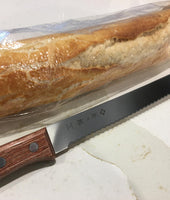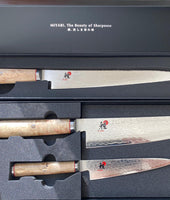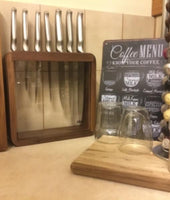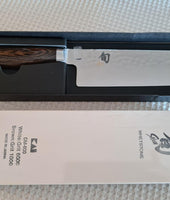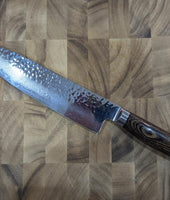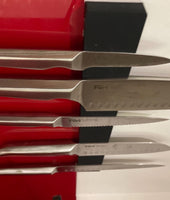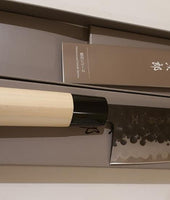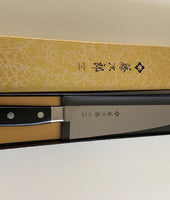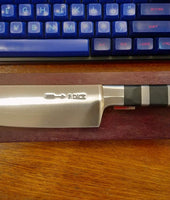The Chef Knife Lover’s Essential Buying Guide
If you walked into random kitchens and checked what knives they have, chances are that the knife you will come across the most is the chef knife.
Originally from France, the chef knife is a versatile kitchen knife that can be used to mince, chop, slice, dice and cut meat and vegetables. It's the easiest knife to own because you don't have to keep trying to remember what to use it for. Here is everything you need to know about chef knives.
Know the different types of Chef Knives
Although the original chef knives are French, other major knife manufacturers also have their version of it.
Here are the main ones:
- The French Chef Knife - Features a straight blade that only curves upwards close to the tip.
- The German Chef Knife - Features a blade with a deep and continuous curve all along the entire edge.
- The Gyuto - The Japanese version of the chef knife. Click here to learn everything about The Gyuto knife.
- The Santoku - A chef knife made in the Japanese style.
- The Chinese chef knife - Which looks like a cleaver.
F Dick Pro-Dynamic Chef's Knife Set Magnetic Case 6 Pc
Know how the blade was made and what materials were used
It's the blade that sets a good Chef Knife apart from those that are not.
The chef knife is your sidekick in the kitchen so even if you're not a professional cook, you need to know all about it. Chef knives have a number of characteristics related to the material that goes into making them and how they look. Here are some of their main features.
Know more about The Blade:
Anatomy of the Blade
The chef knife is typically 6 to 14 inches, though most of them tend to be 8 inches long. The most important part of a knife is obviously the blade. It has a sharp edge with a sloping curve and a prominent point. The shape of the blade allows you to use it in a rocking motion, where you rock the knife blade back and forth from the tip to the heel to cut something. This motion is not possible with the Santoku knife as it has a straighter edge.
Stamped vs Forged blades:
How a chef knife is made determines how hard or soft it will be. Chef knives can either be stamped or forged into existence. What does this mean?
Stamped Blades
A stamped blade is cut out from a piece of steel and heated to strengthen it, after which it is ground, polished, and then sharpened to make the final product. Stamped blades are thinner, lighter, and generally lack a bolster. They are also more affordable than forged blades as their process of manufacture is simpler.
Forged Blades
If you like sturdier knives, a forged blade like the ZWILLING J.A. Henckels Pro Chef Knife 20cm is the one for you. It is made by heating a single piece of steel and then pounding it into shape. The blade is subsequently heated again, quickly cooled down, and then tempered. Lastly, it is polished and sharpened.
Forged blades are generally heavier and thicker than stamped blades, so they're stronger and more long-lasting. That means they're also more expensive. If you're planning to have a chef knife for life, you're better off with one with a forged blade. It may cost you more in the short run but it will save you money in the future.

The Blade Material
The blade material determines a lot of things about a knife, like whether it will rust or not, how strong it is, how heavy or light it is, etc. Some people are clumsy and they need knives that will withstand many accidents. Other people are more interested in edge retention and are not worried about breaking the blade by accident. Here are some common types of blade materials.
Carbon Steel
Well, technically speaking, all steel is carbon steel. Steel is made by blending iron with carbon to make the iron stronger and more rust-resistant. However, in knifespeak, carbon steel usually means an alloy of iron and about 1% carbon.
Carbon steel blades are affordable. They can get very sharp and remain so for a long time. If you're not very good at sharpening, you don't have to worry because they're easy to sharpen, and anyway you won't need to do it frequently.
Their major downside is that they stain easily and have to be well maintained. They need to be thoroughly cleaned, dried, and oiled to preserve the blade as much as possible, but they still corrode. They eventually develop a different texture and color, and sometimes the metallic taste ends up in food. To avoid this, some chefs rest the knives for a day to let the oxidation wear off.
F DICK 1778 Series Plumwood Chef Knife 24cm
Stainless Steel
Sorry to burst your bubble, but stainless steel only exists in wishful thinking. All types of steel eventually corrode or stain, depending on what alloys they're made of. So the proper term is ‘stain-resistant steel’. Still, everyone says ‘stainless steel', so we will too. It's an alloy of a small amount of carbon, plus iron and about 10-15% of chromium, molybdenum, or nickel.
The chromium renders the steel more resistant to corrosion than carbon steel blades. An example of stainless steel is the Japanese VG10 steel commonly used in knives such as the Shun Kai Sora Chef Knife 15cm. The main downside of stainless steel is that it won't hold an edge for very long, so you'll have to keep sharpening it the knife.

Ceramic Blades
Ceramic knives have blades made from a ceramic material known as zirconium dioxide or zirconia.
Ceramic blades are very hard, sharp, and stay sharp longer than steel blades. Once you've sharpened the blade, you can forget about sharpening for a long, long time. Also, unlike carbon and steel blades, the ceramic blade doesn't react with other substances, so it won't stain or corrode.
The thing with ceramic blades is that once you drop the knife, that's it. Because they're so hard, they're brittle, and you have to be careful with them. Also, because they're so delicate, they should only be sharpened by a professional.
Final Words
The chef knife is the best companion for both home and professional cooking. When it comes to heavy, diverse work, it never disappoints. Why don't you take a look at this gorgeous Shun Kai Classic Chef Knife:
Also Read: Common House Kitchen Knives - The Essentials





























